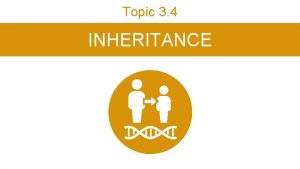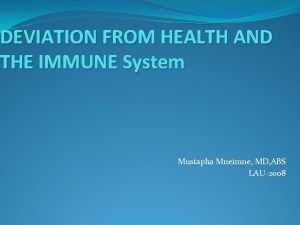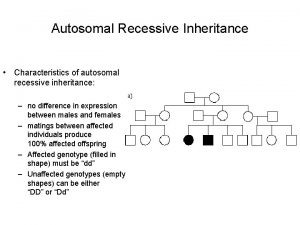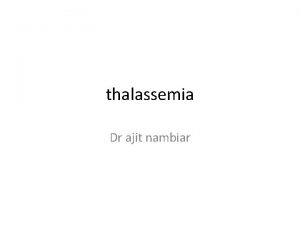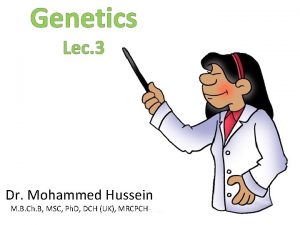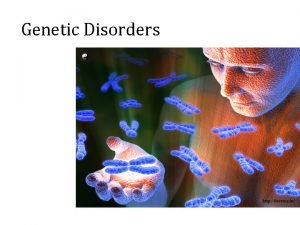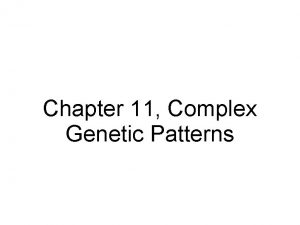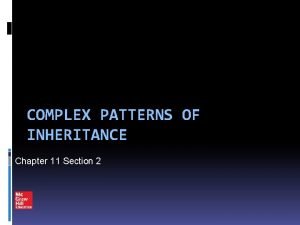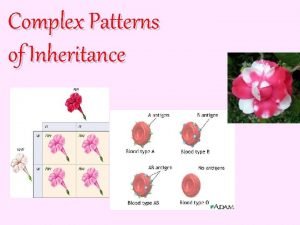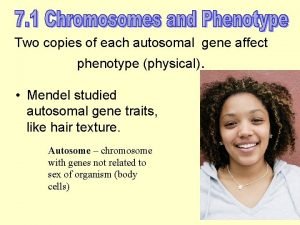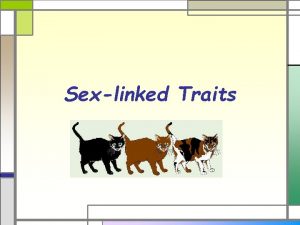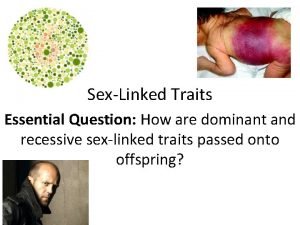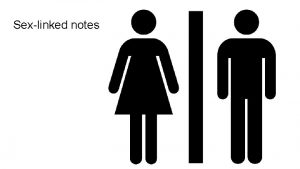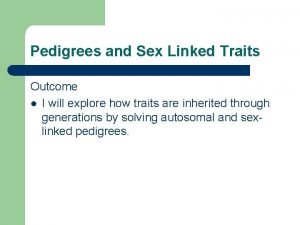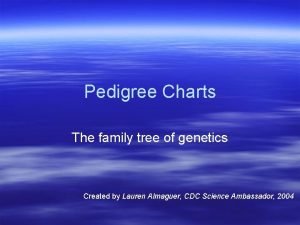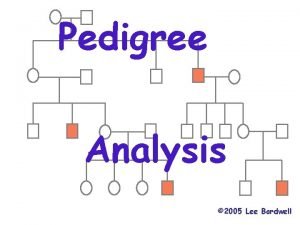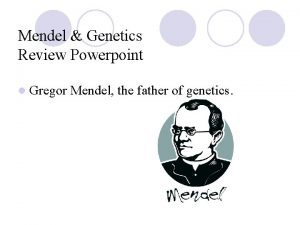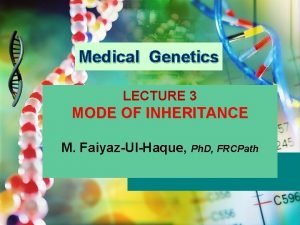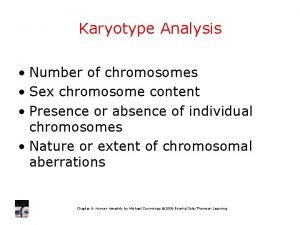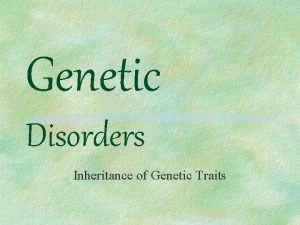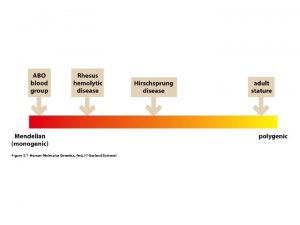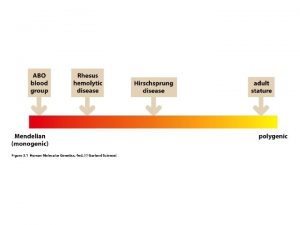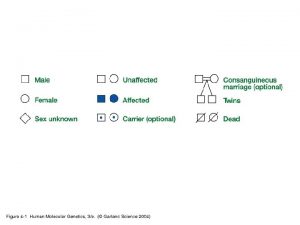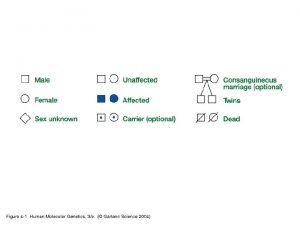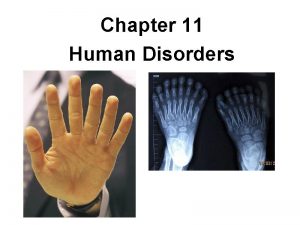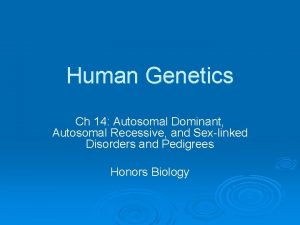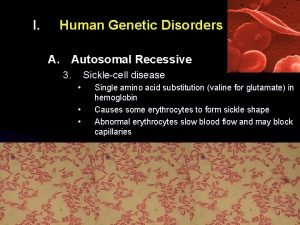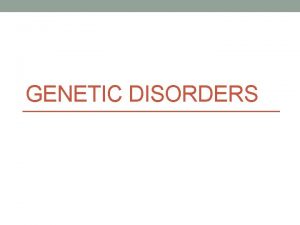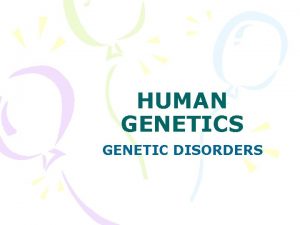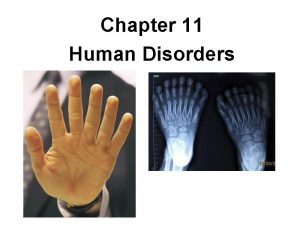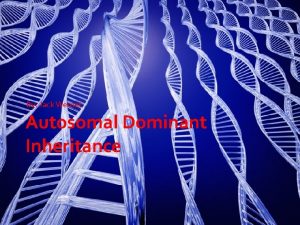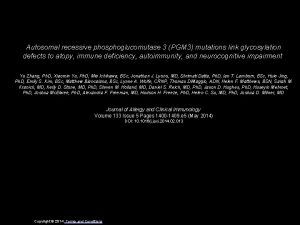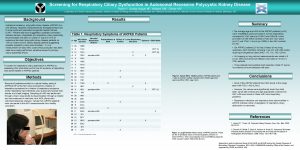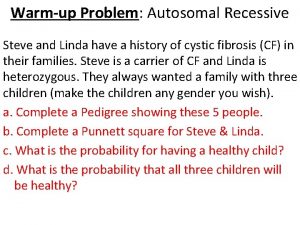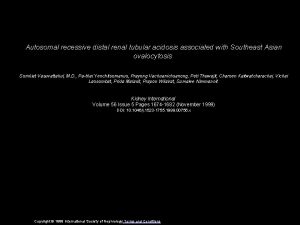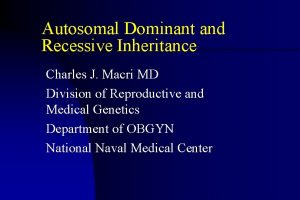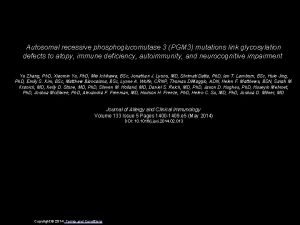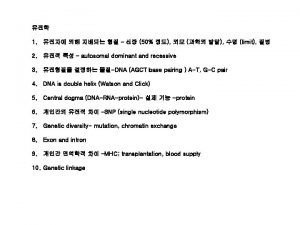Chapter 11 Complex Genetic Patterns Autosomal Recessive Genetic








































- Slides: 40

Chapter 11, Complex Genetic Patterns

(Autosomal) Recessive Genetic Disorders In chapter 10 we discussed that in order for a recessive trait to be expressed, an individual must be homozygous recessive for that trait. Recessive genetic disorders are disorders that are caused by recessive alleles when a person is homozygous recessive for that trait. A person who is heterozygous for a trait does not express the trait but can pass the trait to their offspring. They are called carriers.

Recessive Genetic Disorders

(Autosomal) Recessive Genetic Disorders Cystic Fibrosis – Causes a thick, sticky mucus to build up in the lungs and digestive tract. Average life span (37. 5 yrs. ) Albinism – No color (melanin) in the skin, eyes, and hair. Galactosemia – Inability of the body to break down the simple sugar galactose, which comes from lactose (milk). Symptoms include vomiting, jaundice, diarrhea, weight loss, cataracts, liver, kidney, and brain damage. Tay-Sachs disease – Deadly disease that affects the nervous system and is most common in people of Jewish descent (also found in other groups like

Albinism Mother of five, with three albino children

Dominant Genetic Disorders Dominant genetic disorders. Caused by dominant alleles. If only one parent has one dominant allele (heterozygous), 50% of the children will inherit the disease.

Dominant Genetic Disorders Huntington's disease – Causes nerve cells in the brain to degenerate, causing a gradual loss of brain function. Symptoms most commonly develop in people ages 30 – 50 years old. Achondroplasia – A disorder that affects the growth of bones and causes dwarfism. Polydactyly – A condition resulting in an extra number of fingers and toes. About 1 in 500 people in the United States are born with polydactyly.

Polydactyly

Pedigrees Geneticists use diagrams that trace the inheritance of particular traits through several generations called pedigrees. A pedigree uses symbols to represent different meanings on the pedigree. Males are represented by a square. Females are represented by a circle. Usually someone who expresses a trait is dark. Usually someone without the trait is light. Usually a carrier is half dark and half light.

Pedigrees Horizontal lines between symbols represent parents of the offspring in the lines below them. Offspring are ordered from first to last. Roman numerals represent generations.

Albinism and Polydactyly Pedigrees

Incomplete Dominance Remember from chapter 10 we learned that if an organism's genotype is homozygous dominant (TT) or heterozygous (Tt) the dominant genotype is expressed (will be observed or will occur). In incomplete dominance, when an organism's genotype is heterozygous (Tt), an intermediate phenotype is expressed.

Incomplete Dominance For example, when Red (RR) and White (rr) snapdragons are crossed, the heterozygous offspring are all pink (Rr).

Codominance Codominance is a genetic pattern that occurs when two alleles can be dominant at the same time. For example, in coat color for cattle, you can have red cows (RR), white cows (WW), and roan cows (RW). Roan cows have red and white hairs. In chickens, you can have chickens with black feathers (BB), white feathers (WW), and chickens with black and white feathers (BW), but not gray feathers.

Codominance (Roan Cattle)

Multiple Alleles Sometimes genes can be controlled by more than just two different alleles. For example, blood types in humans are determined by multiple alleles. Humans can have A blood, B blood, AB blood (which is codominant), or O blood (neither A or B blood and O is recessive). Multiple alleles can also be expressed in a hierarchy of dominance. For example in rabbit coat color, Full coat color is dominant to Chinchilla, Chinchilla is dominant to Himalayan, and Himalayan is dominant to Albino.

Multiple Alleles and Dominance Hierarchy

Epistasis Some genes can be altered or modified by the effects of one or more other genes. This genetic pattern is called epistasis. A good example of this is with coat color in Labrador retrievers. In this case, the first gene (E) determines whether or not the fur is dark. A second gene (B) determines how dark the coat color will be.


Polygenic Traits Genes that are controlled by multiple genes at the same time are called polygenic traits One characteristic of polygenic traits is that there tends to be a higher frequency of intermediate traits. When graphed, the frequency of phenotypes for polygenic traits appears as a bell-shaped curve. Some examples of polygenic traits are skin color, eye color, and height.

Polygenic Traits (Skin Color)

Polygenic Traits (Eye Color)

Polygenic Traits (Height)

Sex (Gender) Determination Humans have 46 chromosomes. 2 of those 46 chromosomes are called sex chromosomes. The other 44 chromosomes are called autosomes. Most of your chromosomes are autosomes that determine your traits. Sex chromosomes can determine traits as well, but they also determine your gender or sex.

Sex Determination in Chromosomes Sex chromosomes can be either an X or Y. If an individual's sex chromosomes are both X chromosomes, that person will be a female. If an individual's sex chromosomes are X and Y, that person will be a male.

Sex-Linked Traits that are controlled by genes on the sex chromosomes are called sex-linked traits. Because males have only one X chromosome, they are more likely to be affected by sex-linked traits than females. Females can be affected, but are more likely to be carriers of sex-linked traits. Females are only affected if they inherit both recessive alleles on their x

Are you Color Blind?

How are Sex-linked traits inherited? This would be the result from a cross between a female carrier (XBXb) for color blindness and a normal male (XBY). ½ of the children would be normal ½ would either be color blind males or carrier females

Sex-linked traits Hemophilia is another sex-linked trait that causes delayed blood clotting and can be fatal if untreated. Most sex-linked traits like color blindness and hemophilia affect males more than females. Calico cats are always females because the gene for coat color is on the X chromosome. If a female is heterozygous, she will be a calico cat. Males can only be black or orange. Male pattern baldness is technically an autosomal trait, but it acts like a sex-linked trait. Eye color in Drosophila Fruit flies is a sex-linked trait.

Calico Cats Males can either be black or orange. Females can be black, orange, or calico. This is caused by one of the X chromosomes becoming inactive in female cats.

Queen Victoria's Pedigree (Hemophilia)

Male Pattern Baldness The gene for baldness is recessive in females, but dominant in males. Males can either be heterozygous or homozygous dominant. Females must be homozygous

Drosophila Fruit Flies Red-eyes are dominant to white-eyes in fruit flies. The gene for eye color is a sex-linked trait. In fruit flies, the gene for eye color is found on the X chromosome. Fruit flies make good specimens for studying sex-linked traits.

What are Karyotypes? Some genetic disorders can be caused by the absence of or presence of extra or missing chromosomes. A Karyotype is a photograph of a person's chromosomes arranged in order. They are arranged from largest to smallest. Homologous pairs are arranged together. Once arranged, karyotypes can reveal genetic disorders by looking for abnormalities.

Normal Karyotype

Nondisjunction If chromosomes fail to separate properly during meiosis, the gametes will not end up with the right number of chromosomes. Later on during fertilization if the egg or sperm contains one of these abnormalities, a nondisjunction may occur. If a zygote ends up with one extra chromosome, this results in a disorder called a trisomy (2 n + 1) If a zygote ends up with one less chromosome, this results in a disorder called a monosomy (2 n - 1)

Nondisjunction

Disorders caused by Nondisjunction Down syndrome – result of an extra chromosome number 21 (often called trisomy 21). Symptoms include short stature, heart defects, and mental disability, increased risk of infection. About 1 in 800 children born in the U. S. have Down syndrome. The frequency of children being born with Down syndrome increase with the age of the mother. Mothers over 45 have about a 6% chance (1 in 15) of giving birth to a child with Down syndrome.

Down Syndrome Karyotype

Other Disorders caused by Nondisjunction Turner's syndrome – (XO) Women with only one x chromosome. Symptoms include short height, webbed neck, lack of underarm and pubic hair, and underdeveloped ovaries. Klinefelter's syndrome – (XXY) Symptoms in males include tall height, low IQ scores, speech and language difficulty, sterility. Patau syndrome – (trisomy 13) Heart defects, abnormalities of the eyes, ears, brain and spinal cord, cleft palate and/or lip, small head, low IQ scores, additional fingers and toes, 95% mortality in the first year of life, children rarely live past a few months. Edward’s Syndrome – (trisomy 18) Slow growth before birth, low birth weight, abnormal organ growth, heart defects, small head, 90 -95% mortality rate during the first year.
 Phynelketonuria
Phynelketonuria Alleles are
Alleles are X linked dominant pedigree
X linked dominant pedigree What is a pedigree?
What is a pedigree? Thalassemia facies
Thalassemia facies Genotype of autosomal dominant
Genotype of autosomal dominant Hydrop fetalis
Hydrop fetalis Autosomal recessive cystic fibrosis
Autosomal recessive cystic fibrosis Autosomal recessive
Autosomal recessive Autosomal recessive
Autosomal recessive Telescoping digits
Telescoping digits Is baldness dominant or recessive
Is baldness dominant or recessive Chapter 11 section 2: complex patterns of inheritance
Chapter 11 section 2: complex patterns of inheritance Genetic drift vs gene flow
Genetic drift vs gene flow Genetic programming vs genetic algorithm
Genetic programming vs genetic algorithm Genetic programming vs genetic algorithm
Genetic programming vs genetic algorithm Genetic drift vs gene flow
Genetic drift vs gene flow Gene flow vs genetic drift
Gene flow vs genetic drift Simple compound complex and compound-complex sentences quiz
Simple compound complex and compound-complex sentences quiz Ghon complex and ranke complex
Ghon complex and ranke complex Complex and compound sentences quiz
Complex and compound sentences quiz Freud complexes
Freud complexes Freud's theories
Freud's theories Difference between oedipus complex and electra complex
Difference between oedipus complex and electra complex Complex patterns of inheritance
Complex patterns of inheritance Dating patterns since the 1960s are
Dating patterns since the 1960s are Mining frequent patterns associations and correlations
Mining frequent patterns associations and correlations Autosomal gene
Autosomal gene Sexlinked traits examples
Sexlinked traits examples Autosomal vs sex linked
Autosomal vs sex linked Turner syndrome autosomal or sexlinked
Turner syndrome autosomal or sexlinked Is methemoglobinemia sex linked or autosomal
Is methemoglobinemia sex linked or autosomal Pedigree symbols chart
Pedigree symbols chart Example of sex linked pedigree
Example of sex linked pedigree Autosomal vs sex linked
Autosomal vs sex linked Autosomal vs sex linked
Autosomal vs sex linked Autosomal dominant punnett square
Autosomal dominant punnett square Flurorescein
Flurorescein What is karyotyping
What is karyotyping Jacob's syndrome
Jacob's syndrome Is patau syndrome autosomal or sexlinked
Is patau syndrome autosomal or sexlinked

